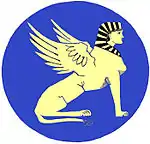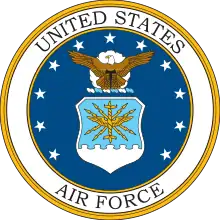104th Aero Squadron
The 104th Aero Squadron was an Air Service, United States Army unit that fought on the Western Front during World War I.
| 104th Aero Squadron | |
|---|---|
 104th Aero Squadron - Foucaucourt Aerodrome, November 1918 | |
| Active | 25 August 1917 – 14 March 1921 |
| Country | |
| Branch | |
| Type | Squadron |
| Role | Corps Observation |
| Part of | American Expeditionary Forces (AEF) |
| Engagements | World War I |
| Commanders | |
| Notable commanders | Capt. Clearton H. Reynolds Capt. William R. Holcombe Capt. Dogan H. Arthur[1] |
| Insignia | |
| 104th Aero Squadron Emblem |  |
| Aircraft flown | |
| Reconnaissance | Salmson 2A2, 1918-1919[2][3] |
| Service record | |
|---|---|
| Operations |
V Corps Observation Group
|
| Victories | |
The squadron was assigned as a Corps Observation Squadron, performing short-range, tactical reconnaissance over the V Corps, United States First Army sector of the Western Front in France, providing battlefield intelligence.[6] After the 1918 Armistice with Germany, the squadron returned to the United States in June 1919 and became part of the permanent United States Army Air Service in 1921, when it was redesignated as the 13th Squadron (Attack) .[2][7]
The current United States Air Force unit which continues its lineage and history is the 13th Bomb Squadron, assigned to the 509th Operations Group at Whiteman Air Force Base, Missouri.[8]
History
The 104th Aero Squadron was organized on 25 August 1917. The unit was formed from all the unassigned recruits at Kelly Field, Texas, who were lined up in formation and 150 men were counted off to form the squadron. No attention was paid to the capabilities of its members at the time, because there were no facilities at Kelly Field for trade testing or flight training. The unit was instructed in close order drill and ordinary post duties.[2][9]
The urgency of the need for men in France led to the squadron receiving orders to report to the Aviation Concentration Center at Garden City, New York, on 30 October. On 28 November the squadron sailed aboard the SS Baltic and arrived at Liverpool, England, on 7 December. The next day, the squadron proceeded to Winchester where they were quartered at the Windall Rest Camp. The Air Service attached the 104th to the British Royal Flying Corps for training. At Winchester, the squadron was split into four flights, with each flight going to a separate English flying school for training.[2][9]
The headquarters flight was established at Winchester, before moving to the Central Flying School at RFC Upavon and then to Netheravon. Other flights went to the Mechanics School at RFC Salisbury, RFC Andover and the motor transport school at RFC Yatesbury.[2][9]
On 10 July 1918, all four flights met at Winchester to prepare for movement to France, but an outbreak of Spanish influenza delayed their movement across the English Channel to Le Havre, France, until 19 July. On the same day the squadron boarded a troop train and arrived at the American Expeditionary Force (AEF) St. Maixent Replacement Barracks on 22 July. After being processed and properly equipped, the squadron first moved to Amanty Airdrome on 1 August where the 104th was classified as a Corps Observation squadron. It then was moved to Epiez Aerodrome on 4 August, where the squadron received its first aircraft, French Salmson 2A2s and was assigned to the V Corps Observation Group. On 8 August the 104th was transferred to the "Zone of Advance" and proceeded to Luxeuil-les-Bains Aerodrome where it joined the 88th and 99th Aero Squadrons of the group.[2][9]
By 8 September the squadron was ready for action, and it moved to Souilly Aerodrome where it participated in the St. Mihiel offensive, serving primarily as the eyes of the artillery. Pilots flew reconnaissance, directed Allied artillery fire and pinpointed troop movements. The demand for artillery fire adjustments through aerial observation was constant in spite of difficulties encountered with air-to-ground communication. It was largely due to the photographs made by aerial reconnaissance that the Allied infantry knew where it was advancing. As the war progressed the demand for observation and reconnaissance by the 104th increased.[2][9]
During the Meuse-Argonne offensive, the 104th operated from Foucaucourt Aerodrome (near Verdun). The squadron continued its previous operations and also engaged the enemy in aerial combat and attacked enemy machine-gun nests. It also dropped thousands of propaganda leaflets over German lines and thousands of newspapers to American soldiers. In the final days of the war the 104th operated from Parois Airdrome, with a flight deployed at Barricourt.[2][9]
The war ended on 11 November 1918, and by the end of that month the 104th was at Belrain Aerodrome where it remained until it could return home. Finally, on 14 January 1919, orders were received to proceed to the 1st Air Depot at Colombey-les-Belles Airdrome, where its equipment would be turned in. The squadron's Salmson aircraft were delivered to the Air Service American Air Service Acceptance Park No. 1 at Orly Aerodrome to be returned to the French. There practically all of the pilots and observers were detached from the Squadron. Personnel at Colombey proceeded to a staging camp at Libourne on 3 February where it remained until moving to the port of Bordeaux on 10 April. On 18 April, the squadron boarded the USS Orizaba, and nine days later it disembarked in New York.[2][9]
The wholesale discharge of personnel soon depleted the l04th's strength. In May the squadron was down to one officer and one enlisted man and was classified as an administrative unit without personnel or equipment at Mitchel Field. New York.[2][9]
For subsequent history see 13th Bomb Squadron
Lineage
- Organized as 104th Aero Squadron on 25 August 1917
- Redesignated 104th Aero Squadron (Corps Observation) on 1 August 1918
- Redesignated 104th Aero Squadron on 28 April 1919
- Redesignated 104th Surveillance Squadron on 25 May 1919[2][3]
Assignments
|
|
Stations
|
|
Combat sectors and campaigns
| Streamer | Sector/Campaign | Dates | Notes |
|---|---|---|---|
| St. Mihiel Offensive Campaign | 12–16 September 1918 | [10] | |
| Meuse-Argonne Offensive Campaign | 26 September-11 November 1918 | [10] |
Notable personnel
|
DSC: Distinguished Service Cross; SSC: Silver Star Citation[11]
See also
References
Notes
- AFHRA 13 Bomb Squadron History Archived 13 October 2014 at the Wayback Machine
- Gorrell, Col. Edgar S. (1974). History of the American Expeditionary Forces Air Service, 1917-1919. Series E. Vol. 9 History of the 104th Aero Squadron. Washington, DC: National Archives and Records Service, General Services Administration. OCLC 215070705.
- Maurer, Maurer, ed. (1982) [1969]. Combat Squadrons of the Air Force, World War II (PDF) (reprint ed.). Washington, DC: Office of Air Force History. ISBN 0-405-12194-6. LCCN 70605402. OCLC 72556.
- Series "H", Section "O", Volume 29, "Weekly Statistical Reports of Air Service Activities, October 1918-May 1919". Gorrell's History of the American Expeditionary Forces Air Service, 1917–1919, National Archives, Washington, D.C.
- Gorrell's History of the American Expeditionary Forces Air Service, Series M, Volume 38, "Compilation of Confirmed Victories and Losses of the AEF Air Service as of May 26, 1919"
- Maurer, Maurer (1978), The US Air Service in World War I, The Office of Air Force History, Headquarters USAF Washington
- Order of Battle of the United States Land Forces in the First World War, Volume 3, Part 3, Center of Military History, United States Army, 1949 (1988 Reprint)
- Rogers, Brian. (2005). United States Air Force Unit Designations Since 1978. Hinkley, UK: Midland Publications. ISBN 1-85780-197-0.
- 13th Bomb Squadron History
- United States War Department (1920), Battle Participation of Organizations of the American Expeditionary Forces in France, Belgium and Italy, 1917–1919, Washington, Government Printing Office, 1920
- Military Times Hall of Valor Search, 104th Aero Squadron
Bibliography
![]() This article incorporates public domain material from the Air Force Historical Research Agency website http://www.afhra.af.mil/.
This article incorporates public domain material from the Air Force Historical Research Agency website http://www.afhra.af.mil/.
- Gorrell, Col. Edgar S. (1974). History of the American Expeditionary Forces Air Service, 1917-1919. Series E. Vol. 9 History of the 104th Aero Squadron. Washington, DC: National Archives and Records Service, General Services Administration. OCLC 215070705.
- Maurer, Maurer, ed. (1982) [1969]. Combat Squadrons of the Air Force, World War II (PDF) (reprint ed.). Washington, DC: Office of Air Force History. ISBN 0-405-12194-6. LCCN 70605402. OCLC 72556.
- Rogers, Brian. (2005). United States Air Force Unit Designations Since 1978. Hinkley, UK: Midland Publications. ISBN 1-85780-197-0.
- United States War Department (1920), Battle Participation of Organizations of the American Expeditionary Forces in France, Belgium and Italy, 1917–1919, Washington, Government Printing Office, 1920
External links
| Wikimedia Commons has media related to 104th Aero Squadron. |

